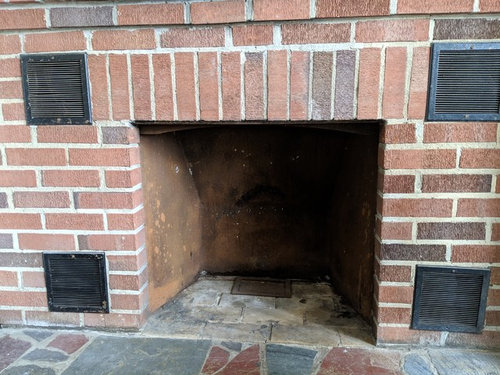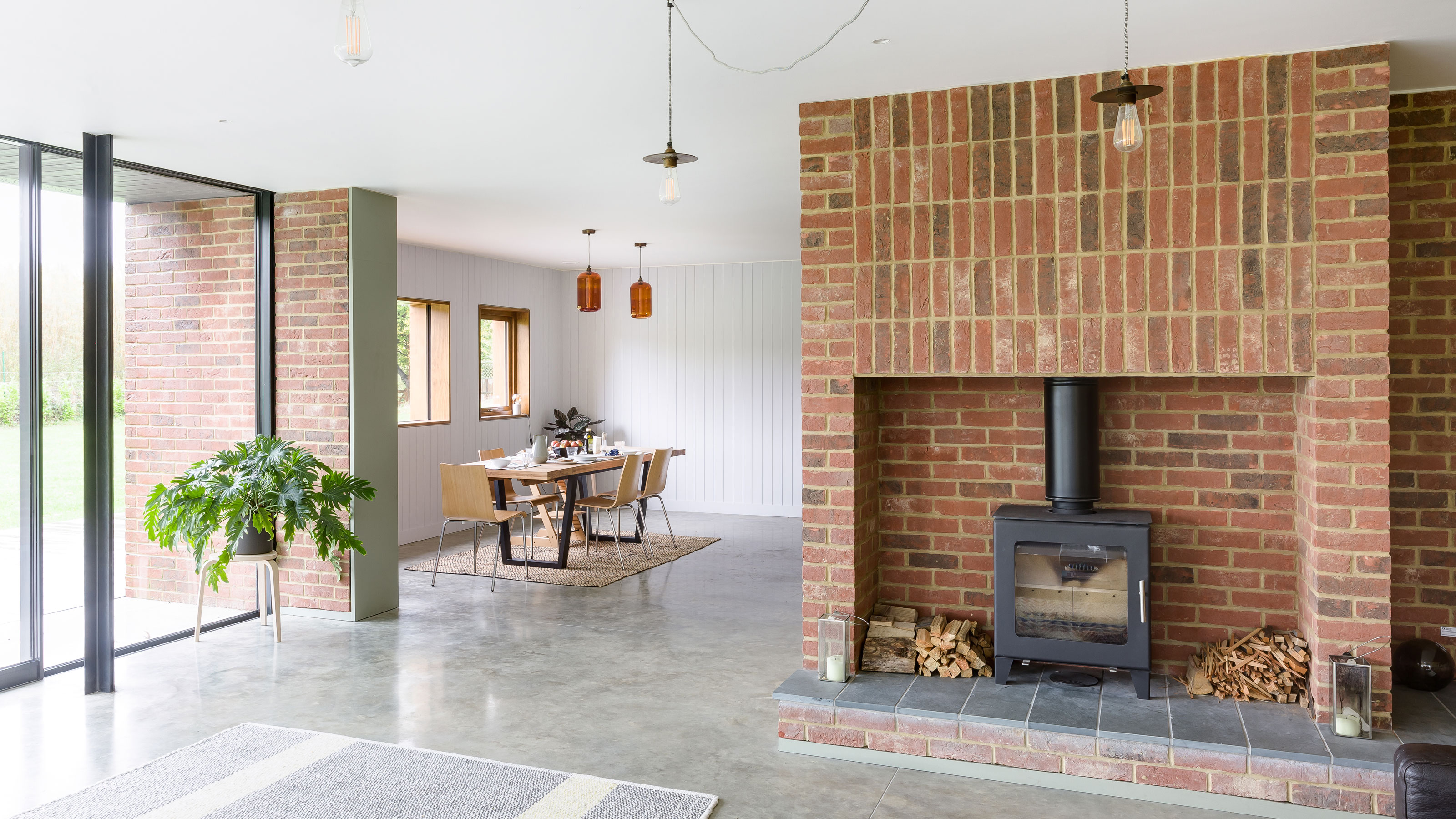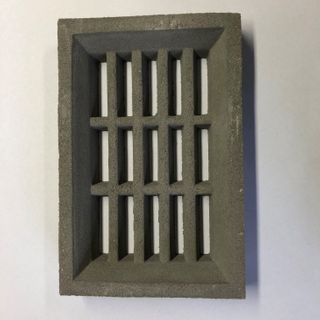Brick Fireplace Vents
Brick fireplace vents are a crucial component of traditional masonry fireplaces, playing a vital role in ensuring the efficient and safe operation of the fireplace. These vents, often referred to as flues, chimneys, or air intake systems, are designed to facilitate the proper flow of air and the expulsion of smoke and combustion gases. The proper functioning of these vents is essential for maintaining indoor air quality and preventing dangerous build-ups of carbon monoxide and other harmful substances. In a brick fireplace, the vents must be well-maintained and correctly installed to ensure optimal performance and safety.

The primary function of a brick fireplace vent is to allow smoke and combustion gases to escape from the firebox and be expelled outside the home. This is typically achieved through a vertical flue that runs from the fireplace to the chimney top. The flue must be appropriately sized to match the fireplace’s dimensions and the volume of air and smoke it needs to handle. If the flue is too small, it can lead to poor draft and smoke backflow into the living area. Conversely, an oversized flue can result in heat loss and inefficient combustion. Therefore, ensuring the correct flue size and design is critical for the fireplace’s effective operation.

In addition to the flue, many brick fireplaces are equipped with air intake vents, which provide the necessary oxygen for combustion. These vents can be located at the base of the fireplace or externally, drawing fresh air from outside the house. Proper air intake is essential for maintaining a healthy fire and preventing the depletion of oxygen levels within the home. Without adequate air supply, the fire can burn inefficiently, produce excessive smoke, and pose health risks. Therefore, the design and placement of air intake vents should be carefully considered during the construction or renovation of a brick fireplace.

Another important aspect of brick fireplace vents is their role in energy efficiency and heat retention. Modern fireplace designs often incorporate features such as damper systems and glass doors, which help regulate airflow and minimize heat loss when the fireplace is not in use. A well-designed damper, located at the top of the chimney or just above the firebox, can be closed to prevent warm air from escaping the home through the chimney. This is particularly beneficial in colder climates, where retaining heat is essential for reducing energy costs. Glass doors can also act as a barrier, preventing drafts and helping to keep the living area warm while still allowing the beauty of the fire to be enjoyed.
Maintenance of brick fireplace vents is crucial for ensuring their long-term functionality and safety. Regular inspections and cleaning of the chimney and flue are necessary to remove creosote buildup, a highly flammable byproduct of wood combustion. Over time, creosote can accumulate on the inner walls of the flue, posing a significant fire hazard. Professional chimney sweeps are equipped with the tools and expertise to safely clean and inspect the chimney, identifying any potential issues such as cracks, blockages, or deteriorating mortar that could compromise the venting system. Addressing these issues promptly can prevent costly repairs and ensure the safe operation of the fireplace.

Finally, brick fireplace vents play a significant role in the overall aesthetic and architectural integrity of a home. The chimney, often visible from the exterior, can be a defining feature of the home’s design. Traditional brick chimneys add a timeless, classic appeal, while modern interpretations might incorporate sleek lines and contemporary materials. Inside, the venting system can be seamlessly integrated into the fireplace design, enhancing the visual appeal and functionality. Whether the goal is to preserve the historical authenticity of a period home or to create a striking focal point in a modern living space, the design and maintenance of brick fireplace vents are integral to achieving the desired outcome.
Brick fireplace vents are essential for the safe, efficient, and aesthetically pleasing operation of traditional fireplaces. Their primary functions include facilitating the escape of smoke and gases, ensuring adequate air intake for combustion, enhancing energy efficiency, and contributing to the home’s architectural design. Proper design, installation, and maintenance of these vents are crucial for preventing hazards such as smoke backflow and creosote buildup, ensuring that the fireplace remains a functional and beautiful feature of the home. Regular professional inspections and cleaning are key to maintaining the integrity and safety of brick fireplace vents, providing peace of mind for homeowners who enjoy the warmth and ambiance of a crackling fire.

OK To Tile Over Vent/gaps On Brick Fireplace?

Fireplace Vents, What Are These For And Can I Seal Them Up?

Refacing Brick Fireplace

How to Easily Paint a Stone Fireplace (Charcoal Grey Fireplace Makeover)

Brick / Masonry Vents
Exterior Wall Vent Covers – Decor IdeasDecor Ideas

Pin on Decor ideas

Related Posts:
- Outside Brick Fireplace Designs
- Brick Fireplace with Bookshelves
- How to Distress Brick Fireplace
- Fireplace Facade Over Brick
- Painting a Brick Fireplace to Look Like Stone
- Cover Brick Fireplace with Stone Veneer
- Brick Fireplace Accent Wall
- How to Clean Red Brick Fireplace
- Jenkins Brick Fireplaces
- Brick Facade Fireplace
Brick fireplace vents are an essential component of any fireplace system, as they help to ensure proper ventilation and air flow in the fireplace. These vents can come in various shapes and sizes, but their main purpose is to allow for the release of smoke, gases, and other byproducts of combustion. In this guide, we will discuss the benefits, pros and cons, common mistakes to avoid, and frequently asked questions related to brick fireplace vents.
Benefits of Brick Fireplace Vents:
1. Proper Ventilation: Brick fireplace vents help to ensure that your fireplace has adequate ventilation, which is crucial for safe and efficient operation. Without proper ventilation, smoke and gases can build up inside the fireplace, creating a potential fire hazard.
2. Improved Air Quality: By allowing for the release of smoke and gases outside of the home, brick fireplace vents help to maintain good indoor air quality. This is especially important for those with respiratory issues or allergies.
3. Regulatory Compliance: Many building codes require the installation of brick fireplace vents to comply with safety regulations. Ensuring that your fireplace is properly vented can help you avoid costly fines or penalties for not being up to code.
4. Aesthetically Pleasing: Brick fireplace vents can add a decorative element to your fireplace, enhancing the overall look and feel of the room. They come in a variety of styles and designs to complement any decor.
Pros and Cons of Brick Fireplace Vents:
Pros:
– Effective at removing smoke and gases from the fireplace
– Helps maintain good indoor air quality
– Adds a decorative touch to the fireplace
– Can be customized to match the style of your home
Cons:
– Requires regular maintenance to ensure proper functioning
– Installation can be complex and may require professional help
– May be costly upfront depending on the design and materials used
– Could potentially become blocked by debris or animals if not properly maintained
Common Mistakes to Avoid with Brick Fireplace Vents:
1. Neglecting Regular Maintenance: One common mistake homeowners make is neglecting to regularly clean and inspect their brick fireplace vents. Over time, soot, debris, and even animals can block the vent, leading to poor ventilation and potential safety hazards.
2. Improper Installation: Another mistake is attempting to install a brick fireplace vent without professional help. Improper installation can lead to inefficiency, safety risks, and non-compliance with building codes.
3. Ignoring Warning Signs: If you notice any unusual odors, smoke backing up into the room, or difficulty starting a fire in your fireplace, it may be a sign that your brick fireplace vent is not functioning properly. Ignoring these warning signs can lead to more serious issues down the line.
4. Using Incorrect Materials: When cleaning or maintaining your brick fireplace vent, be sure to use materials that are safe for use with brick surfaces. Harsh chemicals or abrasive tools can damage the brick finish and compromise the integrity of the vent.
1. Can I install a brick fireplace vent myself?
While it is possible to install a brick fireplace vent yourself, it is recommended to seek professional help to ensure proper installation and compliance with building codes.
2. How often should I clean my brick fireplace vent?
It is recommended to clean your brick fireplace vent at least once a year or more frequently if you use your fireplace frequently.
3. Are there different types of brick fireplace vents available?
Yes, there are various types of brick fireplace vents available, including wall vents, chimney caps, and direct vents. The type you choose will depend on the design and layout of your fireplace.
4. What should I do if my brick fireplace vent becomes blocked?
If you suspect that your brick fireplace vent is blocked, it’s important to stop using your fireplace immediately and contact a professional for inspection and cleaning.
5. Can I paint my brick fireplace vent?
It is generally not recommended to paint a brick fireplace vent as this could interfere with its function and durability. If you wish to change the color or appearance of your vent, consider consulting with a professional for alternative options such as staining or sealing.
Brick fireplace vents play a crucial role in ensuring the safe and efficient operation of your fireplace. By providing proper ventilation and allowing for the release of smoke and gases, these vents help to maintain good indoor air quality and comply with building codes. It is important to avoid common mistakes such as neglecting maintenance, improper installation, ignoring warning signs, and using incorrect materials when it comes to brick fireplace vents. If you have any questions or concerns about your brick fireplace vent, it is best to consult with a professional for guidance and assistance.
Overall, brick fireplace vents offer many benefits such as proper ventilation, improved air quality, regulatory compliance, and aesthetic appeal. However, it is important to be aware of the pros and cons associated with them, as well as common mistakes to avoid in order to ensure their optimal performance. By taking these factors into consideration and properly maintaining your brick fireplace vent, you can enjoy a safe and efficient fireplace system for years to come. If you have any doubts or questions regarding your brick fireplace vent, always seek advice from a professional to address any concerns.
Remember, safety should always be the top priority when it comes to your fireplace system. Proper maintenance and regular inspections of your brick fireplace vent are key to ensuring that it functions effectively and safely. By following the tips and advice provided in this guide, you can enjoy the many benefits of having a well-maintained and properly vented fireplace in your home. If you have any further questions or concerns, don’t hesitate to reach out to a professional for assistance. Stay safe and warm by keeping your brick fireplace vent in top condition!
